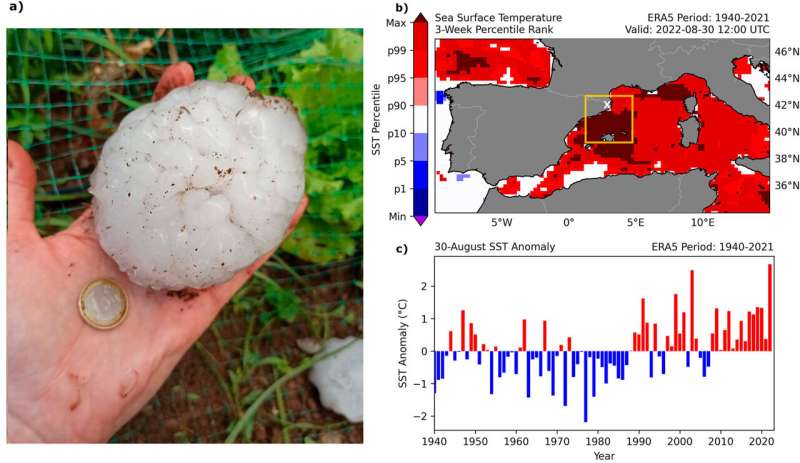Editors' notes Spain's giant hail event worsened by marine heat waves, study finds
APRIL 2, 2024 FEATURE
by Hannah Bird , Phys.org

a) Giant hailstone pictured in Gerona, Spain, during the August 2022 event. b) Sea surface temperature change for 30th August event with respect to data across the period 1940-2021. Gerona is indicated by the white X. c) Sea surface temperature anomalies averaged across the study area and period. Credit: Martin et al. 2024.
Hail is a semi-frequent visitor to winter, and occasionally summer, seasons across the globe and tends to pass by in a short but sharp downpour that can often be overlooked. However, sometimes these meteorological phenomena are hard to ignore. This was the case on 30 August 2022, when Gerona, north-eastern Spain, experienced a severe event in which individual hailstones reached a massive 12cm—the largest ever documented in the country. This led to serious damage to buildings, cars and agricultural areas, as well as 67 injuries and one fatality.
Untangling the cause of this unusually extreme hail event is at the heart of new research published in Geophysical Research Letters. Professor Maria Luisa Martin, of Universidad de Valladolid, Spain, and colleagues investigated the role a record-breaking marine heat wave had in exacerbating the hail storm.
The Iberian Peninsula experienced a sea surface temperature increase of an average 3.27°C protracted over six weeks in the summer of 2022, the highest on record. The research team found that atmospheric convective energy reached unprecedented levels, thus alongside moisture from a warm ocean, enhanced supercell (storms with vertical rotation of rising air currents) development in the Pyrenees, leading to the meteorological phenomenon of hail.
To explore this further, the scientists used a dataset of >280 documented supercells from 2011 to 2022 (with 57 citing large hailstones >5cm diameter, and four giant hailstone events where they exceed 10cm diameter) to simulate the hail event both with and without the influence of a marine heat wave in the Mediterranean Sea. Increased sea surface temperature is known to be one of many consequences of global warming, and it has a direct impact on the frequency and intensity of prolonged (>5 days) heat wave events.
More:
https://phys.org/news/2024-04-spain-giant-hail-event-worsened.html
